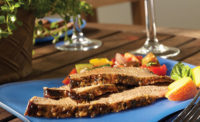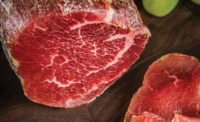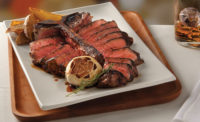For millennia, we humans have delighted in the flavor and mystical seasoning that wood smoke brings to meats. What began as a happy consequence of cooking over open wood fires progressed over time into a means of preservation and ultimately a sinful delight in a gustatory sense.
I could never claim to be an expert in this form of cookery; however, my adventures as a meat-stronaut (yep, just made that one up) have allowed me to connect with those keepers of the flame who would be designated doyens of smoked meats. As a liaison to pit masters, I have had the opportunity to sample and suggest a number of cuts from the beef carcass that have surprised even the most experienced in the subject of smoked meat cuisine.
The most traditional beef barbecue item that comes to mind for the smoked meats connoisseur would surely be the brisket. Simple in structure, affordable and delightfully tasty, the brisket flat (Pectoralis profundus) can offer both lean and fattier portions to satisfy nearly any palate. But in recent years, the brisket has become so much more sought after that, as a meat scientist acting in the interest of consumers, I have been challenged to seek alternative beef cuts that could be used in the smoker.
The bottom round flat, long used for roast beef and generally maintaining a rather affordable price point, has demonstrated itself as an attractive alternative, at least to the leaner portion of the beef brisket. Some may wonder if it is too lean, but when cut from a highly marbled carcass such as one that meets Certified Angus Beef® brand specifications, the bottom round flat will maintain a sufficient juiciness, even after the long cook necessary for smoking.
Another barbecue item I have had the privilege of tasting a la smoke is the chuck roll. When 3-inch-thick roasts are cut perpendicular to the longitudinal axis of the subprimal and subsequently smoked, the chuck roll brings memories back to the deep pit smokers I grew up around in the hills of northern California. This is an inherently well-marbled cut with seams of just enough fat that create a delightful and delectable dining experience. Smoked chuck roll can be enjoyed in chunked form or chopped, making it perfect for a beef barbacoa or taco filling. (Hungry yet?)
One cut that does incredibly well in the smoker is the beef knuckle or sirloin tip, and its smaller “kissing cousin,” the ball tip. Both are made up of muscles from the quadriceps group, but the ball tip tends to be smaller and thus cooks more quickly. These cuts contain long muscle fibers that, when slow-cooked (e.g., smoked) shred amazingly well and result in a dining product similar to that of shredded pork shoulder. Both of the beef cuts work well — the ball tip tends to be a smidge more costly per pound — yet still great buys.
Finally, although it has gained such wide popularity that it may not result in savings compared to brisket, the bone-in short rib has shown great potential for the smoked beef enthusiast. To start with, it’s an unbelievable presentation for the eyes to see the large, Fred Flintstone-esque rib bone attached to the highly marbled short-rib muscles. Beef short ribs can be smoked cross-cut style, too, or even boneless. The marbling in this cut, regardless of origin (chuck, rib or plate) brings a rich flavor and amazing texture. The bone-in option is just so impressive that it substantiates the metaphor that we also “eat with our eyes.”
Smoking meats, specifically using a low-and-slow cookery (200 to 250 degrees F) with natural wood or charcoal fuels to impart the unique flavor of the smoke itself, has been historically executed on lesser-valued cuts that tend to be located on the ends of the quadruped (primarily the shoulder/chuck and round). That’s where longer cooking allows a better breakdown of connective tissue to tenderize those cuts. But one cannot overlook the value of the legendary essence of wood smoke even on traditionally more tender middle meats. Cooking these at a higher temperature (300 to 400 degrees F) over natural wood fuels can bring the richness of smoke aroma and flavor to the prime rib, strip loin and even tenderloin.
Although smoking and barbecue cookery in general is often associated with other species of meat-producing animals, both two- and four-legged, smoked beef cuts bring out a depth of flavor that is unparalleled to that from other barnyard dwellers. I encourage everyone to experiment with their favorite beef cuts in a smoked meats setting.
Just be sure to invite me over to sample the creations.
Go, beef! NP
“Get Real with Beef” is written by Dr. Phil Bass, senior meat scientist for the Certified Angus Beef® brand, Editorial Board Member of The National Provisioner and one of NP’s “25 Future Icons.” Watch for his insights, including his take on beef cuts that processors should investigate adding to their product mix, on a quarterly basis, exclusively in The National Provisioner.






Report Abusive Comment